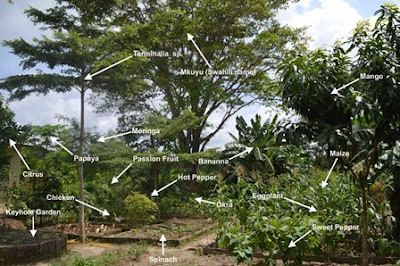PDC LESSON 2.8 DESIGN – CREATE AN HERB SPIRAL
PERMACULTURE
COURSE AGRO-ECONOMY
PDC LESSON 2.8 DESIGN – CREATE AN HERB SPIRAL
Create an herb spiral for the garden
An herb spiral not only offers a
great opportunity to plant different herbs in your own garden but is also a
very special feast for the eyes. It is practical that there is always a large
selection of fresh herbs available. An herb spiral works with a very simple
trick: thanks to the spiral shape, different humid and climate zones can be
simulated in a very small space - including a pond.
A herb spiral offers different
plants enough space in a small space. Several zones ensure optimal growth. The
Mediterranean herbs grow at the top.
Herb spiral has four zones
With a slight ascent to the
highest point, the herb spiral is divided into four zones: At the bottom is the
wet area. Water-loving plants such as watercress or water mint find their place
here. Adjacent to the wet zone is the wet zone, where chervil, parsley, basil
and wild garlic grow well. Plant chives, coriander and mint in the normal area.
The highest point of the spiral is the warmest and driest: this is the
Mediterranean zone. Sage, thyme, marjoram, rosemary, oregano, lavender and
laurel thrive here.
The materials needed:
pegs, cord; spade; Clinkers, coarse gravel; garden soil, sand, compost; Prefabricated pond, construction vat; Stones to build up the spiral wall; Find and mark out a suitable place
As a first step, the selection of
the location is crucial. The pitch should have a diameter of at least three
meters and be as sunny as possible. Each herb spiral can be designed
individually. It is only important that the plants have enough space to
develop. Once you have found the right location, simply mark out a floor plan
with the help of pegs and cord. This should remind of a snail shell. Important:
The pond should be placed at the end of the spiral facing south. This is the
only way to guarantee that each plant gets the right climate zone.
Form the basis with gravel and build a wall
Next, a spade is required: In
total, the soil for the spiral should be dug about 30 centimetres deep. Only
the pond at the foot of the spiral should be dug about 10 centimetres deeper.
To prevent waterlogging and to lay a stable foundation, the hole in the ground
is filled with a 10-centimetre-thick layer of coarse gravel. However, the spot
where the pond will later find its place should remain without gravel. To erect
the wall, the stones are laid out in a spiral, increasing in height from the
outside to the inside. The wall should reach 80 centimetres at the highest
point. In order to make it look particularly natural, no mortar should be used
if possible. This also has the advantage that thyme and dost can be planted in
the crevices and useful animals such as lizards can find a home there.
Adjust and paste soil mixes
The herb spiral offers different
plants enough space in a small space.
Once the wall is up, the gravel
can be added. It is important to fill in the gravel from the height in a
spiral, so that the highest point is 50 centimetres, and the layer is almost
level at the lower end. To fill the spiral with soil, you must consider the
different climate zones. At the top of the spiral, half of the garden soil
should be mixed with sand to match dry zone plants. Towards the lower,
outflowing end, less and less sand should be used, and compost should be added
instead until the pond has a mixed ratio of half garden soil and half compost.
In the end, the spiral should resemble a snail shell, with a flat start at the
outer end of the spiral and a raised point in the middle.
Creation of the pond
The last step is to create the
pond. Either a ready-made pond from the hardware store or a simple construction
vat is suitable for this. The container should sit about 30 to 40 centimetres
deep. So it can be easily inserted into the pre-made hole. Then fill the
container with sand and pour water into it. The edge can be decorated with
field stones.
It takes patience to plant
Do not put the herbs in the bed immediately
but wait for a good shower and then add some soil if necessary. But then the
season of delicious and fragrant herbs can begin.
These herbs are suitable for planting
4 watercress; 1 chervil; 1 leaf parsley; 1 basil (perennial); 1 wild garlic; 2 chives; 1 coriander; 1 pineapple mint; 1 pineapple sage; 1 lemon thyme; 1 ball thyme; 1 perennial marjoram; 1 rosemary; 1 oregano (spicy); 1 hanging oregano; 1 lavender; 1 laurel
Text from the roots, Elisabeth Ferkonia (Aus.) PDC studied with Bill Mollison,



Comments
Post a Comment